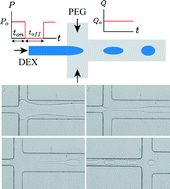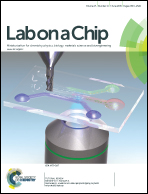Microfluidic generation of aqueous two-phase system (ATPS) droplets by controlled pulsating inlet pressures†
Abstract
We present a technique that generates droplets using ultralow interfacial tension aqueous two-phase systems (ATPS). Our method combines a classical microfluidic flow focusing geometry with precisely controlled pulsating inlet pressure, to form monodisperse ATPS droplets. The dextran (DEX) disperse phase enters through the central inlet with variable on–off pressure cycles controlled by a pneumatic solenoid valve. The continuous phase polyethylene glycol (PEG) solution enters the flow focusing junction through the cross channels at a fixed flow rate. The on–off cycles of the applied pressure, combined with the fixed flow rate cross flow, make it possible for the ATPS jet to break up into droplets. We observe different droplet formation regimes with changes in the applied pressure magnitude and timing, and the continuous phase flow rate. We also develop a scaling model to predict the size of the generated droplets, and the experimental results show a good quantitative agreement with our scaling model. Additionally, we demonstrate the potential for scaling-up of the droplet production rate, with a simultaneous two-droplet generating geometry. We anticipate that this simple and precise approach to making ATPS droplets will find utility in biological applications where the all-biocompatibility of ATPS is desirable.


 Please wait while we load your content...
Please wait while we load your content...